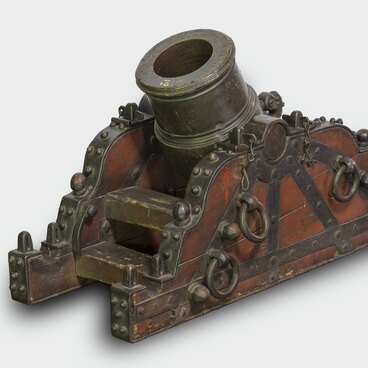For special achievements in military operations, emperors granted valuable gifts not only to specific people, but also to entire army and navy units. Among the insignia were inscriptions on military headdresses, silver St. George trumpets, honorary banners and standards.
In 1800, Paul I awarded the Moscow, Tauride, Smolensk and Arkhangelsk regiments with memorable battle banners.
Under Alexander I, the St. George standards were introduced. Unlike the usual ones that featured a double-headed eagle on the pommel of their shaft, these standards were crowned with a St. George cross, and the standard tassels were fixed on an orange and black St. George ribbon instead of a silver ribbon. For the first time, the newly established medals were bestowed upon the Kiev Grenadier Regiments and two Cossack Don hosts in 1806.
According to the regulations, the infantry was granted banners, while the cavalry was presented with standards; the Cossacks had only one regimental banner, in some units there were also company and battalion banners. Light cavalry (the mounted jaegers, hussars and Uhlans) was not entitled to be granted a standard based on rank, but it could be earned in battle. In any case, the banner (or the standard) was sacred for the unit. An inscription with the date and description of the feat was embroidered on the awarded banners and standards, as well as imperial monograms and emblems.
The honorary award could also be taken away: it was withdrawn for fleeing from the battlefield without a command to retreat. If the banner was lost or captured by the enemy, it was not reissued.
In 1878, banners began to feature a sign of the highest distinction — the St. George’s ribbons. They were to be added to banners with previously existing inscriptions. In addition, the guards were given blue St. Andrew’s ribbons, and the army — red Alexander’s ribbons.
The tradition remained until the revolution of 1917.
The standard presented in the exhibition is one of five granted by Alexander I to the Life Guards Horse Regiment of Major General Ivan Fedorovich Yankovich de Mirievo “For capturing the enemy banner from the French at Austerlitz on November 20, 1805.”
The feat of privates Gavrilov, Omelchenko, Lazunov and Ushakov of the 2nd squadron earned the only trophy in this otherwise unsuccessful battle.
Before the revolution, the standards were kept in the regimental church. In 1918, the standard of the 1st squadron (regimental) became part of the collection of the Historical Museum of Artillery, where it is still housed.
In 1800, Paul I awarded the Moscow, Tauride, Smolensk and Arkhangelsk regiments with memorable battle banners.
Under Alexander I, the St. George standards were introduced. Unlike the usual ones that featured a double-headed eagle on the pommel of their shaft, these standards were crowned with a St. George cross, and the standard tassels were fixed on an orange and black St. George ribbon instead of a silver ribbon. For the first time, the newly established medals were bestowed upon the Kiev Grenadier Regiments and two Cossack Don hosts in 1806.
According to the regulations, the infantry was granted banners, while the cavalry was presented with standards; the Cossacks had only one regimental banner, in some units there were also company and battalion banners. Light cavalry (the mounted jaegers, hussars and Uhlans) was not entitled to be granted a standard based on rank, but it could be earned in battle. In any case, the banner (or the standard) was sacred for the unit. An inscription with the date and description of the feat was embroidered on the awarded banners and standards, as well as imperial monograms and emblems.
The honorary award could also be taken away: it was withdrawn for fleeing from the battlefield without a command to retreat. If the banner was lost or captured by the enemy, it was not reissued.
In 1878, banners began to feature a sign of the highest distinction — the St. George’s ribbons. They were to be added to banners with previously existing inscriptions. In addition, the guards were given blue St. Andrew’s ribbons, and the army — red Alexander’s ribbons.
The tradition remained until the revolution of 1917.
The standard presented in the exhibition is one of five granted by Alexander I to the Life Guards Horse Regiment of Major General Ivan Fedorovich Yankovich de Mirievo “For capturing the enemy banner from the French at Austerlitz on November 20, 1805.”
The feat of privates Gavrilov, Omelchenko, Lazunov and Ushakov of the 2nd squadron earned the only trophy in this otherwise unsuccessful battle.
Before the revolution, the standards were kept in the regimental church. In 1918, the standard of the 1st squadron (regimental) became part of the collection of the Historical Museum of Artillery, where it is still housed.



